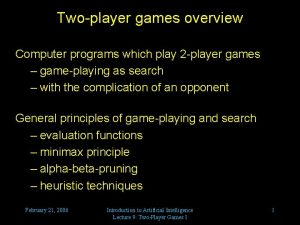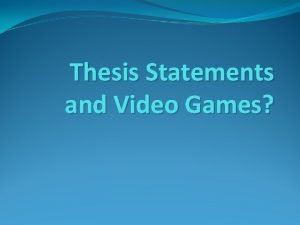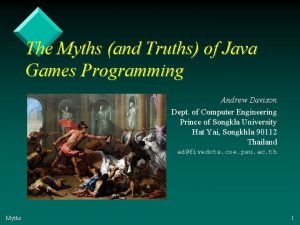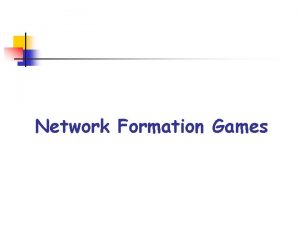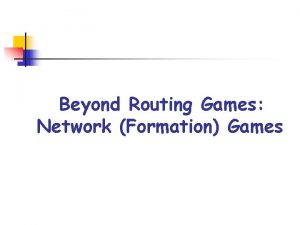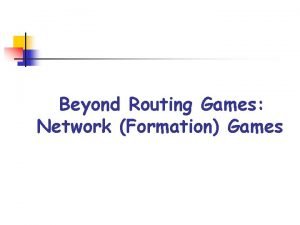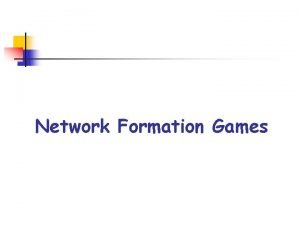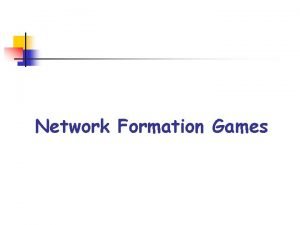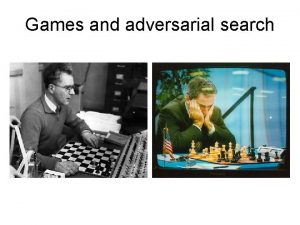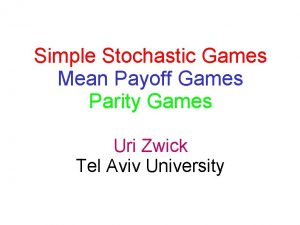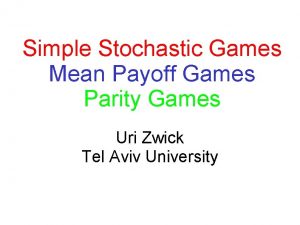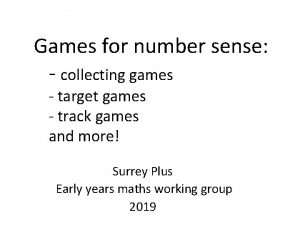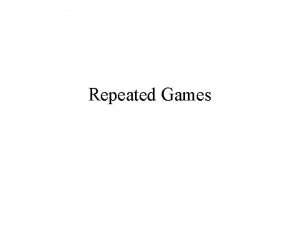Network Formation Games Netwok Formation Games n n































- Slides: 31

Network Formation Games

Netwok Formation Games n n NFGs model distinct ways in which selfish agents might create and evaluate networks We’ll see two models: n n n Global Connection Game Local Connection Game Both models aim to capture two competing issues: players want n n to minimize the cost they incur in building the network to ensure that the network provides them with a high quality of service

Motivations n NFGs can be used to model: n n n social network formation (edge represent social relations) how subnetworks connect in computer networks formation of networks connecting users to each other for downloading files (P 2 P networks)

Setting n What is a stable network? n n n How to evaluate the overall quality of a network? n n we use a NE as the solution concept we refer to networks corresponding to Nash Equilibria as being stable we consider the social cost: the sum of players’ costs Our goal: to bound the efficiency loss resulting from stability

Global Connection Game E. Anshelevich, A. Dasgupta, J. Kleinberg, E. Tardos, T. Wexler, T. Roughgarden, The Price of Stability for Network Design with Fair Cost Allocation, FOCS’ 04

The model n n n G=(V, E): directed graph ce: non-negative cost of the edge e E k players player i has a source node si and a sink node ti player i’s goal: to build a network in which ti is reacheable from si while paying as little as possible Strategy for player i: a path Pi from si to ti

The model n n Given a strategy vector S, the constructed network will be N(S)= i Pi The cost of the constructed network will be shared among all players as follows: costi(S) = ce/ke e P i ke: number of players whose path contains e this cost-sharing scheme is called fair or Shapley cost-sharing mechanism

Remind n n n We use Nash equilibrium (NE) as the solution concept Given a strategy vector S, N(S) is stable if S is a NE To evaluate the overall quality of a network, we consider the social cost, i. e. the sum of all players’ costs cost(S)= i costi(S) n a network is optimal or socially efficient if it minimizes the social cost Notice: cost(S)= e N(S)ce

Addressed issues n n Does a stable network always exist? Can we bound the price of anarchy (Po. A)? Can we bound the price of stability (Po. S)? Does the repeated version of the game always converge to a stable network?

an example 3 s 2 3 1 s 1 3 2 4 1 1 1 t 1 5. 5 t 2

an example 3 s 2 s 1 1 3 3 2 4 optimal network has cost 12 cost 1=7 cost 2=5 is it stable? 1 1 1 t 1 5. 5 t 2

an example 3 s 2 s 1 3 2 1 1 1 4 t 1 5. 5 …no!, player 1 can decrease its cost 1=5 cost 2=8 is it stable? …yes! the social cost is 13 t 2

an example 3 s 2 s 1 3 …a better NE… 2 4 1 1 1 t 1 5. 5 cost 1=5 cost 2=7. 5 the social cost is 12. 5 t 2

Price of Anarchy: a lower bound k s 1, …, sk t 1, …, tk 1 optimal network has cost 1 best NE: all players use the lower edge Po. S is 1 worst NE: all players use the upper edge Po. A is k

Theorem The price of anarchy in the global connection game with k players is at most k

Price of Stability: a lower bound >o: small value t 1, …, tk s 1 1 s 2 0 1/3 1/2 s 3 0 1/(k-1) 1/k sk-1 . . . 0 0 0 sk 1+

Price of Stability: a lower bound >o: small value t 1, …, tk s 1 1 s 2 0 1/3 1/2 s 3 0 1/(k-1) 1/k sk-1 . . . 0 0 The optimal solution has a cost of 1+ is it stable? 0 sk 1+

Price of Stability: a lower bound >o: small value t 1, …, tk s 1 1 s 2 0 1/3 1/2 s 3 0 1/(k-1) 1/k sk-1 . . . 0 0 …no! player k can decrease its cost… is it stable? 0 sk 1+

Price of Stability: a lower bound >o: small value t 1, …, tk s 1 1 s 2 0 1/3 1/2 s 3 0 1/(k-1) 1/k sk-1 . . . 0 0 …no! player k-1 can decrease its cost… is it stable? 0 sk 1+

Price of Stability: a lower bound >o: small value t 1, …, tk s 1 1 s 2 0 1/3 1/2 s 3 0 1/(k-1) 1/k sk-1 . . . 0 0 sk 1+ 0 A stable network social cost: k 1/j = Hk ln k + 1 j=1 k-th harmonic number

Theorem Any instance of the global connection game has a pure Nash equilibrium, and best response dynamic always converges Theorem The price of stability in the global connection game with k players is at most Hk , the k-th harmonic number To prove them we use the Potential function method

Notation: x=(x 1, x 2, …, xk); x-i=(x 1, …, xi-1, xi+1, …, xk); x=(x-i, xi) Definition For any finite game, an exact potential function is a function that maps every strategy vector S to some real value and satisfies the following condition: "S=(S 1, …, Sk), S’i Si, let S’=(S-i, S’i), then (S)- (S’) = costi(S)-costi(S’) A game that posses an exact potential function is called potential game

Theorem Every potential game has at least one pure Nash equilibrium, namely the strategy vector S that minimizes (S) proof consider any move by a player i that results in a new strategy vector S’ we have: (S)- (S’) = costi(S)-costi(S’) 0 costi(S) costi(S’) player i cannot decrease its cost, thus S is a NE

Theorem In any finite potential game, best response dynamics always converge to a Nash equilibrium proof best response dynamics simulate local search on : 1. each move strictly decreases 2. finite number of solutions Note: In the GC game, a best response can be computed in polynomial time

Theorem Suppose that we have a potential game with potential function , and assume that for any outcome S we have cost(S)/A (S) B cost(S) for some A, B>0. Then the price of stability is at most AB proof Let S’ be the strategy vector minimizing Let S* be the strategy vector minimizing the social cost we have: cost(S’)/A (S’) (S*) B cost(S*)

…turning our attention to the global connection game… Let be the following function mapping any strategy vector S to a real value: (S) = e e(S) where e(S)= ce H ke k Hk= 1/j j=1 k-th harmonic number

Lemma Let S=(P 1, …, Pk), let P’i be an alternate path for some player i, and define a new strategy vector S’=(S-i, P’i). Then: (S) - (S’) = costi(S) – costi(S’) Lemma For any strategy vector S, we have: cost(S) Hk cost(S)

Theorem Given an instance of a GC Game and a value C, it is NPcomplete to determine if a game has a Nash equilibrium of cost at most C. proof Reduction from 3 -dimensional matching problem

3 -dimensional matching problem n Input: n n n disjoint sets X, Y, Z, each of size n a set T X Y Z of ordered triples Question: n does there exist a set of n triples in T so that each element of X Y Z is contained in exactly one of these triples? X Y Z

the reduction 3 3 3 T edges of cost 0 s 1 s 2 X si Y s 3 n Z There is a 3 D matching if and only if there is a NE of cost at most C=3 n

the reduction 3 3 3 T edges of cost 0 s 1 s 2 X si Y s 3 n Z a 3 D matching implies a NE of cost C=3 n if no 3 D matching exists then any solution costs more than C=3 n
 Network formation games
Network formation games The hunger games chapter questions
The hunger games chapter questions Types of games indoor and outdoor
Types of games indoor and outdoor Formation initiale vs formation continue
Formation initiale vs formation continue Serious games network
Serious games network Comparison of virtual circuit and datagram networks
Comparison of virtual circuit and datagram networks Network topologies
Network topologies Features of peer to peer network and client server network
Features of peer to peer network and client server network Network systems design using network processors
Network systems design using network processors Network centric computing and network centric content
Network centric computing and network centric content Distinguish between circuit switching and packet switching
Distinguish between circuit switching and packet switching Blockly games bird
Blockly games bird Target games examples
Target games examples Plokmijnuhbygvtfcrdxeszwaq games
Plokmijnuhbygvtfcrdxeszwaq games Waptrice game
Waptrice game Wandsworth school games
Wandsworth school games Type of ball games
Type of ball games Twoplayer games
Twoplayer games Twoplayer games
Twoplayer games Low organized games
Low organized games Tipp 24
Tipp 24 Thesis statement games
Thesis statement games Powerpoint template olympic games
Powerpoint template olympic games Plato computer
Plato computer Pirate game sheet
Pirate game sheet The olympic games are an international sports festival
The olympic games are an international sports festival Open source java games
Open source java games Kumeyaay baskets
Kumeyaay baskets Swot analysis of mobile game industry
Swot analysis of mobile game industry Communicuffs
Communicuffs Settings in the hunger games
Settings in the hunger games What is the physical condition of peeta and katniss?
What is the physical condition of peeta and katniss?

















